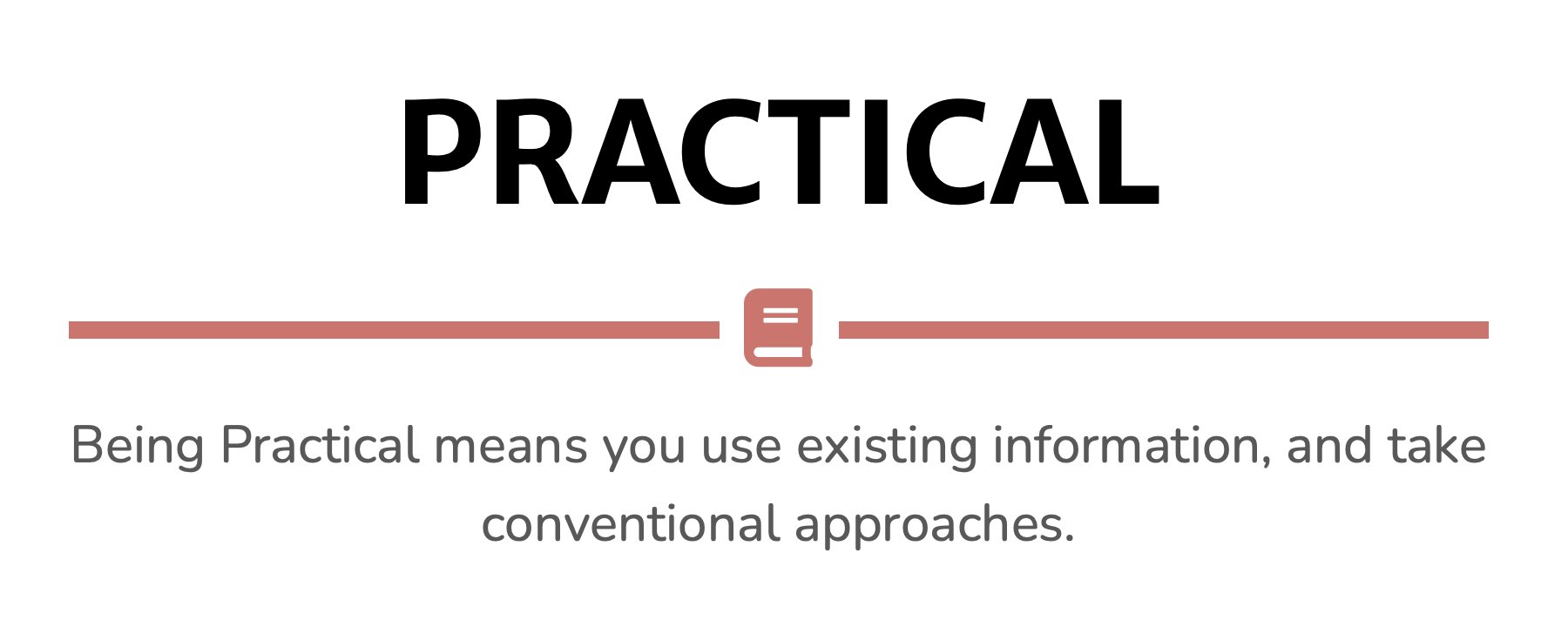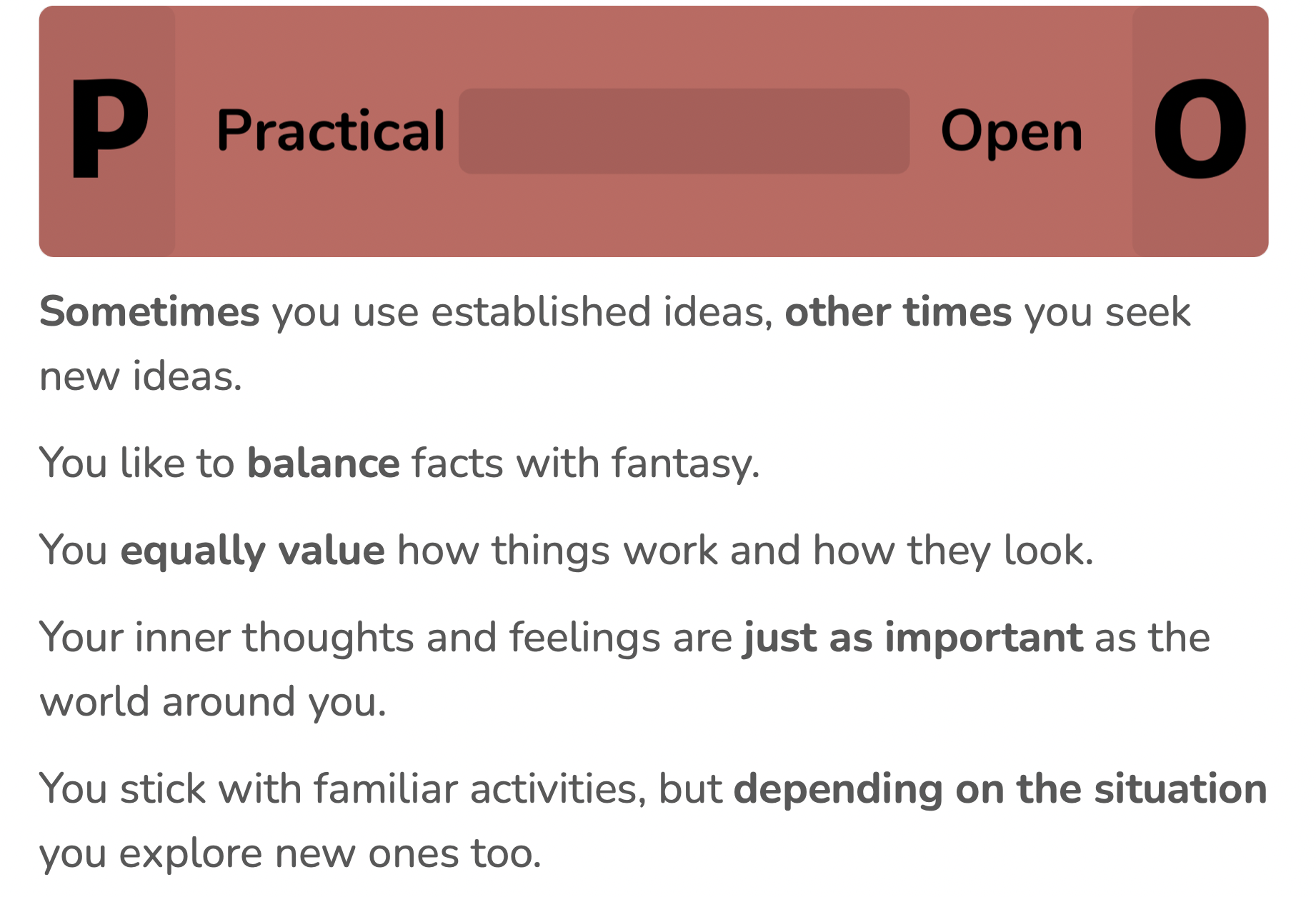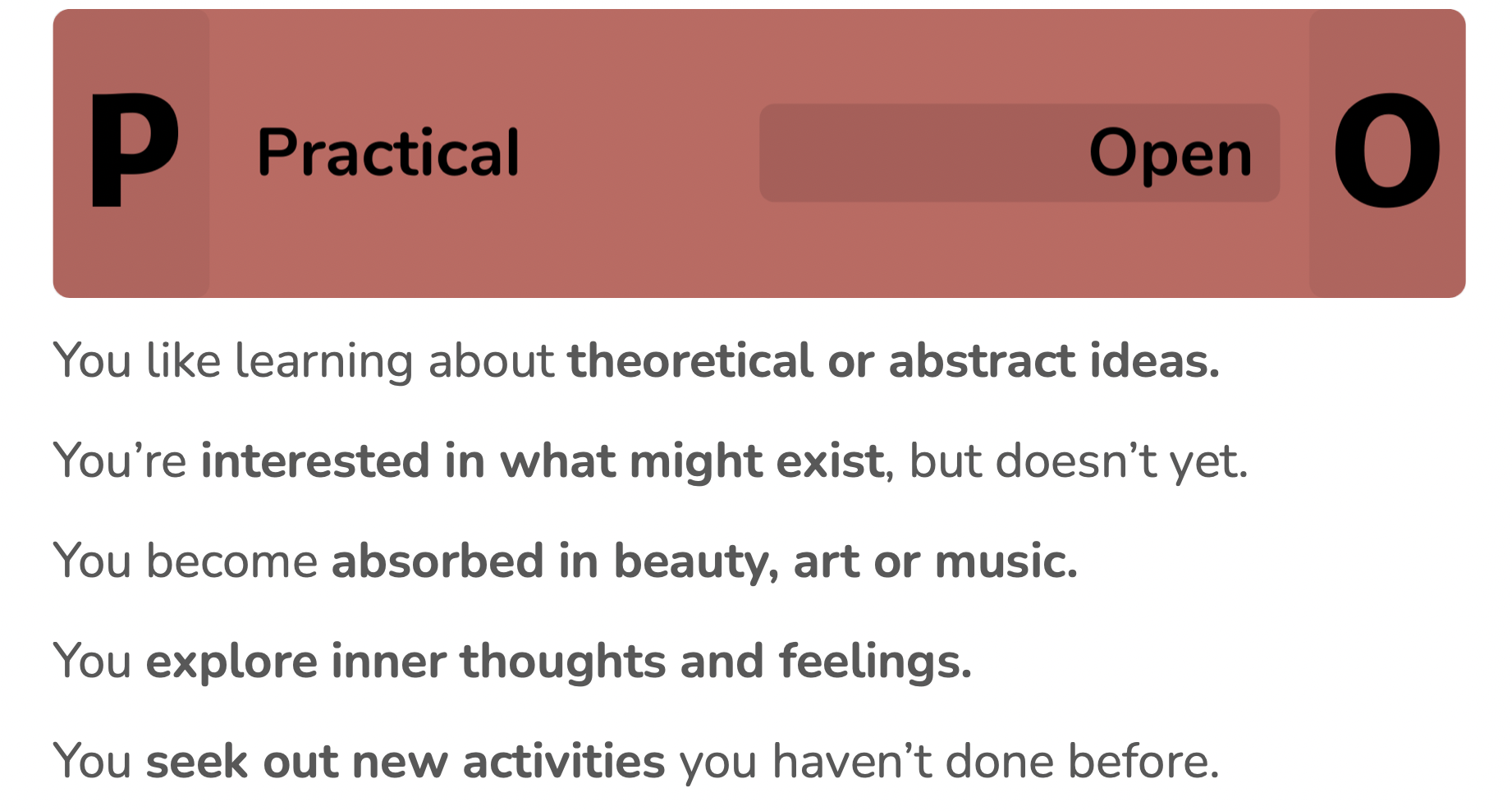Openness
Openness is the information system of your personality.
In any situation, it's that part of you asking:
Do I have enough ideas, or do I need new ones?
Do I stick with my current behavior, or try a new approach?

This is the most complete guide of Openness to experience in 2022.
By reading it, you will walk away able to better spot Openness in yourself, other people, and be able to use it in your life.
If you want to more deeply understand Openness, its definition, learn examples, and how to apply it....
Then you'll love this guide.
Let's jump in!
Overview
Openness to experience is the first personality dimension in the OCEAN Big Five personality model.
Now the most widely accepted model, the Big Five was discovered using decades of statistical analysis and survey data.
Researchers discovered that our personality traits exist in our language (the lexical hypothesis).
So they decided to jump into the dictionary.
They dove right in and gathered all of the words we use to describe each other.
Using millions of surveys and a statistical method called factor analysis, they officially organized these words into a cohesive framework.
This framework is called the OCEAN Big Five.

Definition
Openness to experience is the OCEAN Big Five personality factor that measures and describes your cognitive exploration.
In any situation you find yourself in, its the conscious and subconscious system of your brain and senses which is always asking the question:
"Is it worth gathering new information here, or trying a new approach?"

The Information System
Openness to experience is your Information system.
So what's a "System?"
A system is a collection of elements or components that are organized for a common purpose.
Let's describe this through synonyms: Dimension, cluster, scale, tendency, preference, grouping.
A system is just a combination of similar patterns of thinking, feeling, and behaving.
Studying the lexical hypothesis, researchers discovered that all humans have five broad personality systems or dimensions.
Openness describes how likely your brain and your senses are to go gather new information versus just work with the existing information you have.
This information can be ideas, visuals, feelings, actions.
Heritability
Openness to experience can be best described when we talk about its purpose.
Why did we even evolve as humans to have this personality trait in the first place?
To survive and to thrive.
Look at it this way...
Since openness is the "Information" system of your personality, its job is to decide how much (or how little) information our senses and brain should take in and process, and whether or not to act on that information.
Our personality traits are inherited from our biological parents.
https://en.wikipedia.org/wiki/Genomics_of_personality_traits
Just like other physical traits, personality traits come from our genes.
Through millions of years of evolution, the genes that helped your ancestors survive and thrive got passed down to you.
That means that Openness to experience has helped you survive and thrive for millions of years!
Subtraits
The Facets of Openness
Also called sub-traits, these facets are
Just consider facets sub-traits. These are smaller traits that are all related to each other, and when combined makeup Openness to experience.
Because the Big Five is a lexical personality model, all of these facets are synonyms of one kind or another.
LINK - NEO or Goldberg
The Aspects of Big Five
Another very important personality research, Colin DeYoung, made another big contribution to the hierarchy and understanding of personality dimensions.
He concluded that directly underneath the Big Five Dimensions are these sub-traits called Aspects. These will all make more sense in the diagram below.
DIAGRAM
Openness Test
For educational purposes, you can take our free openness to experience quiz below. It's meant to simply show you both sides of the openness dimension, and give you a quick result.
It's only 5 questions:


















You can learn more about Practical here.
You can learn more about Open here.
Low vs High
Neither.
Instead, the question is....
In what situations are you Practical or Open?
You see:
Being high or low are both totally normal.
In fact, most people are somewhere in the middle.
High Openness = Open
Imagine the most curious person you've ever met. They are always asking philosophical questions, trying new things, and are very creative. You would describe this person as high in Openness to experience.
Low Openness = Practical
Now imagine someone you know who really prefers routine, sticking to the same tasks, and just likes talking about the real world. You would describe this person as low openness to experience.
Both people's tendency of deciding how much (or how little) information to gather and process are completely normal.
In fact:
Our relationships, teams, companies, governments, and society all operates best when people who are both Practical and Open are part of them!
However, some situations go better when we can appropriately balance being Practical or Open, depending on what's needed. Further in this article, we will give you tips on how to be more the other way.
Keep reading.
Same vs New
Examples



Self-knowledge is your greatest asset on your journey of life.
Cognitive Exploration
Practical
Open
Standard Distribution
Published Journals


Openness

Conscientiousness

Extraversion

Agreeableness

Neuroticism

Why is the Big Five Important?
Personality has been a topic of interest since the ancient Greeks.
Since then, psychologists have made many "guesses" as to what personality is. Some of these include the Myers Briggs, Enneagram, and DiSC.
Today, we don't need to make many guesses and can use language, research and experience to measure and define personality.
Put simply:
The Big Five is important because it gives us a shared personality model that's accurate, reliable, and valid.
Because:
You are not a "type"
You are not a "color"
You are not a "number"
You cannot be put into 4, or 9, or 16 different groups.
You have strengths and weaknesses
You are one of the most complex things in the universe and you deserve a better explanation of who you are than what's been given to you!
You are not defined by your personality, but your personality is an essential factor when starting to explain yourself and those around you.
Thousands of Published Research Papers
Big Five has the most published research papers of any personality model.
Big Five History (Timeline)
100 Years Ago
Curiosity prompted Gordon Allport to begin compiling the words we humans use to describe each other (lexical hypothesis). They started in the dictionary. The list was 4,504 words.
50 Years Ago
Advances in computing and statistics (factor analysis) allowed researchers to correlate these words to one another and boil down the list to 16 dimensions...
20 Years Ago
Sharing their findings in academic journals, separate research teams like Lewis Goldberg (IPIP) and Costa & McCrae (NEO) found these words could be organized into five broad personality domains: "The Big Five"
Today
Any and all researchers, academics, and scientists use the Big Five when they want to measure, understand, and explain individual human behavior.
Now the Most Accepted Personality Model
The Big Five is now the most widely accepted personality model among researchers, academics. scientists, and leaders.
In this chapter, we’re going to cover what the the big five personality dimensions actually are, where they came from, and how to begin understanding them.
Question's Answered:
- What are Traits?
- Where do they come from?
- How do they work?

What are the Big Five Traits?
As you might remember, using factor analysis (a statistical method that correlates how related words are to other other words) researchers discovered these five traits (also called "dimensions" or "factors" or "systems" or "scales")
Here they are again:
- Openness to experience
- Conscientiousness
- Extraversion
- Agreeableness
- Neuroticism
Basically any adjective you would use to describe the thoughts, feelings, or behavior of someone falls into one of these five domains.
For example, think of someone you know, right now.
What are some words you would use to describe them?
Believe it or not, whatever words you just came up with can be categorized under one of the big five domains.
Take a look:
- "Curious" falls under Openness
- "Hard-working" falls under Conscientiousness
- "Kind" falls under Agreeableness
- "Lively" falls under Extraversion
- "Moody" falls under Neuroticism
Organizing our words into broad categories makes it much more useful to understand, define, and communicate with other people.
Openness to Experience
The way you gather Information and how you use it.

Conscientiousness
The way you Control and order the world around you.

Extraversion
How much Activity and energy you use in the world.

Agreeableness
How much you Cooperate and collaborate with other people.

Neuroticism
How your mind and body notices Threats and feels negative emotions.

Traits, not Types
This is the most important breakthrough in personality research. Traditional (and outdated) personality models suggest that people can be neatly organized into "types".
Put simply, you are not a type and you cannot be put neatly into a box.
Instead:
You have consistent tendencies and patterns of thinking, feeling, and behaving a certain way. The Big Five just defines what these are.
Just like in evolution, there is a lot of diversity and variation in personality traits.
Being in the Middle is Normal
The second most important breakthrough in personality research is that the middle exists, and it's larger than you'd think.
Yes, it's possible to be extreme (high or low) on a trait.
But:
Most people are in the middle on any given personality trait.
When you take the entire population and plot them statistically, we all come out looking like a bell curve. Most people are somewhere in the middle,
What we've found:
You likely have one or two traits that you are higher or more extreme in.

You can be Situational
It's also very common for people to be "situational" with these traits.
For example, being introverted could be one of your strongest traits. You prefer quiet, low-key environments. But that doesn't mean you are introverted ALL of the time.
Rather:
If you are with your best friend, you are likely much more engaging and talkative. But if you are at a big party, you are likely more introverted.
The rule of thumb:
When the situation is strong, the situation dictates your behavior.
When the situation is weak, then your personality traits come out more.
Personality comes from your Genes
Nature vs nurture....
The most common "debate" since Darwin.
Today, we know that your initial traits come from your DNA aka your parents.
Just like you inherit your height, hair color, or eye color and many other traits.
But also:
Epigenetics has shown us that as you grow up, your traits interact with the environment, which continues to shape how your traits express themselves.
Your personal experiences will shape the traits you are born with.
Which brings us to...
Personality Can Change
Another hotly contested topic that's been debated for centuries...
Can you actually change?
YES!
Longitudinal research has shown that people's traits can change overtime.
Basically:
Your traits are stable, but not fixed.
This means they remain relatively the same throughout your lifetime, but they are not set-in-stone by any means.
Even though your traits are stable, you can change your personality traits through your environment, experiences, self-awareness, and deliberate action.
But first, let's start by learning what your traits are.
In this chapter you will learn the basics of the PRISM-OCEAN personality traits.
Questions Answered:
- What is PRISM-OCEAN?
- Where can I take a free OCEAN test?

Start with Your Traits
There are many things that influence your behavior.
Such as:
Values, societal roles, jobs, life story, family, religion.
These are all very important!
But:
The best place to start learning about yourself is through your personality traits.

